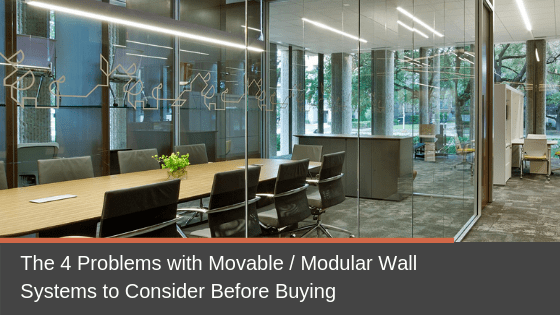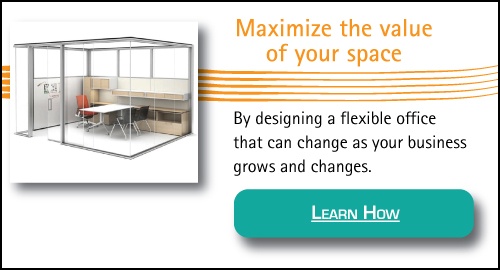Do you anticipate having to increase your office staff in the near future and need offices to accommodate them? Maybe your business needs have changed, and you require more open meeting spaces. Moveable walls and modular wall systems can offer you the flexibility to change the configuration of your office space to adapt to your changing needs.
There are many benefits to adopting a moveable, modular wall system. However, there are some considerations to think about before investing.
In this article, we’ve included some background on moveable walls along with the potential problems and suggested solutions that we have come across most often with our customers.
Moveable Walls: The Basics
The concept behind modular wall systems is much like modular systems furniture. They’re both reconfigurable as needed. Modular walls can be wired for power and data, and also offer the benefits of increased visual and auditory privacy.
Modular walls offer some substantial advantages such as flexibility and the ability to easily add – or subtract – private offices, quiet workspaces, the ability to add training areas, or private meeting space, and control noise whenever staff or work needs change. Best of all, they’re reusable and produce no waste.
Modular wall systems may also offer tax advantages when categorized as furniture and equipment. While they may cost more upfront than fixed walls, over the long-term, their life span and eco-benefits make them a smart investment for many businesses.
Potential Problems to Consider When Adding Modular Wall Systems
While modular systems offer flexibility, it’s essential to consider several factors to avoid challenges and potential problems. When considering a modular system think about how long you’ll be at your current location.
Do you own your space, or are you leasing? What are your needs – for example, will you need to increase your staff for specific projects, and how much stock do you think you’ll need to meet your needs? Other potential parameters to consider are HVAC, lighting, sprinklers and acoustics.
Potential Problem #1 – Configuration of workstations and delivery of power complications.
Solution – There can be several compromises when it comes to power distribution. Access floor systems are an excellent solution but can be pricey. Ceiling plenums will also work well, but when systems do not have ceiling to floor coverage, it can mean a sea of power poles.
Alternatively, using a core and drill approach by drilling the slab to run electrical underneath can accommodate both full-sized walls and cubicles or half walls. Be sure to take into account your furniture layout early in the planning stages of your project.
Potential Problem #2 – Moveable walls are a sizeable investment – drywall is a less expensive solution.
Solution – It is undoubtedly cheaper to throw up a drywall partition than a moveable wall partition… the first time. If you consider the cost required to take down walls and the framing, taping, and mudding required for drywall installation, it doesn’t take long for costs to add up when reconfiguring a space. If you use drywall and move out of the building, you’ll have to leave your investment behind.
Moveable walls have the electrical and data cabling built-in, saving you time and money by eliminating the need to rewire the reconfigured space.
Potential Problem #3 – We are looking for something that will match our office décor and finishes.
Solution – Suppliers today offer many different finish options from which to choose. Some even offer custom painting to match the colours in your office. Glass panels can also be incorporated into your design to add interest to your office space and provide natural daylight and exterior views even in rooms near the building’s centre.
These panels can easily be detached from their adjacent panels and reattached in their new location. Prices can vary, so be sure to do your research!
Potential Problem #4 – The time needed to reconfigure our modular wall system will disrupt my business.
Solution – Even though there are multiple types of moveable wall systems, from modular walls to demountable systems that require a more specialized approach to changing office layouts, the underlying system is still the same – the moveable walls snap into place with the need for little labour.
A private office suite using a moveable wall system can be disassembled, moved and reassembled in less than a day, far less time than drywall.
The Bottom Line
Movable wall systems certainly cost more upfront than traditional drywall construction, but that cost is usually recovered as soon as you reconfigure your space. They can improve productivity, provide a flexible work environment, help control acoustics and when combined with raised floor access, can optimize an organic approach to workplace design that can work to maximize how responsive your workplace is to organizational change.
Moveable walls are far from perfect, but it is hard not to recommend them to any customer willing to pay the higher initial price.
Considering a moveable wall system for your office? Check out our white paper Optimizing Adaptable Workspaces with Movable Walls and learn how moveable walls can help maximize the efficiency of your space.
Cory Porteous
Director of Marketing & Inbound Business Development
Office Interiors




